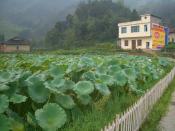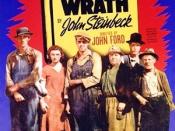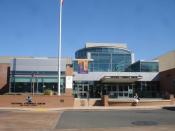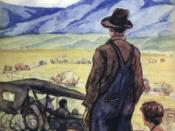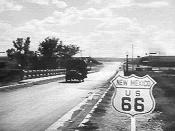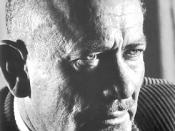"Symbolism"� In John Steinbeck's novel The Grapes of Wrath there were many symbols which played an important role in the development of the book. The book wouldn't be nearly as good as it is if it didn't have the turtle, the journey, the animals and ants, or the Biblical parallels.
The people took the journey to follow the American Dream. The American Dream is one of the prevalent themes in the book. Everyone has a different American Dream, and it has changed a lot over the years. The American Dream is to be successful, and the people were successful if they stayed alive and kept their families alive. To be successful means something different for every person, and the Joads wanted to thrive but they dreamed of something that seemed somewhat out of their reach. Surviving is a big part of the American Dream, but there is more to it.
Ma believes that no matter what happens people will survive, so her American Dream was the frosting on the cake of life (the frosting being a house with a white picket fence), not the cakes center (the center being survival). "We are the people. We go on"� "We got to go on now. We got to go on down."�(294) The American Dream for some of the Joads was to get a house with a white picket fence around it. It's not much to ask for, but the house with the white picket fence slipped right through their fingers. At least they survived, and by the end they seemed content with their newfound knowledge of man's brotherhood.
In the book their journey was symbolic of the fact that people do what they have to do to survive, and if they stay alive they have accomplished part of their own American Dream. They left everything, not by choice, but because they had no other option.
" "ÃÂIt ain't kin we? It's will we?' she said firmly. "ÃÂAs far as "ÃÂkin,' we can't do nothin', not go to California or nothin'; but as far as "ÃÂwill,' why, we'll do what we will.' "�(132). The Joads couldn't go to California, but they had to because it's in man's instinct to do anything he can to survive. The Joads were one family that was supposed to symbolize all of the families going west. The journey symbolized the struggle to survive; it symbolized the fact that they had no other alternative, they embarked on the journey not because they were brave people looking for new land, but because they were taking the one option laid out in front of them. "It don't take no nerve to do somepin when there ain't nothin' else you can do."�(284). The people that were part of the westward movement took problems as they came and solved them. The solution to the problem of the Joads was the journey. The Joads needed a solution and needed one fast as they raced against time and tractors. Taking a journey west was the only answer that came up. With the thirteen million other farmers being pushed off their land and moving west the Joads figured it was the best thing to do; it was the only thing to do. They needed to survive and they did; maybe miserably, but most of the people did survive. " "ÃÂYeah, but when a fence comes up at ya, ya gonna climb that fence.' "ÃÂI climb fences when I got fences to climb.' "�(224). Tom spoke for all of the people moving west; he deals with the problems of that day and doesn't look back and doesn't worry about what's to come. He does whatever it takes to get over the fence, but doesn't do it prematurely. The problem with this fence was that he had to take a journey, one that he willingly did to survive.
The turtle was one of the best symbols of the book. Steinbeck chose the perfect animal to symbolize the people and their movement westward. A turtle takes everything with him, his home is on his back and his necessities are along for the ride. One of the things the turtle symbolized was the people's truck. The people took their homes with them; they took everything with them. The Joads truck had the same shape as the turtle. Their truck was piled high with their belongings, and that was like the turtle's shell. Their trucks became their homes. Steinbeck pointed out the fact that the truck was like a turtle; "And the truck crawled slowly through the dust toward the highway and the west."�(147) "The turtle entered a dust road and jerked itself along."�(21). The Joads and Wilsons were also obviously referred to as turtles when it talked about them "Joads and Wilsons were in flight across the panhandle"æ"�(210) then a sentence later said, "The land turtles crawled through the dust and the sun whipped the earth"æ"�(210). The people were the turtles, making their way slowly but steadily through the dust and onward to California.
The turtle first came up in chapter three when he was making his journey across the highway. He had many obstacles in front of him just as the people did: the turtle had to climb the embankment, get through traffic while getting hit by a car, go across a burning hot highway, and then get down on the other side and not know what laid in store for him when he got there. The people faced many obstacles also: the Rocky Mountains (embankment), the sweltering heat (hot road), the open road and the police that kept hitting them off track (the car), and then when they finally made it to California they were not certain of what was in store for them. When the turtle made it across the highway, he dropped a seed off his back; "The wild oat head fell out and three spearhead seeds stuck in the ground. And as the turtle crawled down the embankment, its shell dragged dirt over the seeds."�(21). This symbolized the fact that the people transported their seeds across the country. The people planted a seed and made life go on no matter who is against them. A turtle is very persistent and keeps on going no matter what. They do what they have to do to survive. " "ÃÂNobody can keep a turtle though. They work at it and work at it, and at last one day they get out and away they go""off somewheres.' "�(27). Nobody can keep a turtle down and no one can keep people down either because they will rise and survive. The people held hunger marches, and rose above the depression by living through it. The turtle is persistent just like the people and it carries its house and belongings with it. It is a perfect symbol.
In the book there are many Biblical parallels. The Biblical parallel's function is to bring in new ideas and make you think. They make you think about where God was when this happened, and they bring to your attention good and evil, sins, and the morals that deal with them. Two of the most obvious parallels in the book are; parts of the book are written in a King James style, and Casey is to be viewed as somewhat of a Jesus character for the book. "I been in the hills, thinkin' almost you might say like Jesus went into the wilderness to think his way out of a mess of troubles."�(104). Even his name is symbolic; Jim Casey and Jesus Christ. Also the people go from putting the family first to putting whoever is in need first. You can have morals and good and evil without religion, but it sure makes it more interesting to include biblical parallels.
The concepts of sins and evil permeate the book. Casey has different views on everything; sins, morals, and people. Casey explains it best when he says, "Sure I got sins. Ever'body got sins. A sin is somepin you ain't sure about. Them people that's sure about ever'thing an' ain't got no sin""well, with that kind a son-of-a-bitch, if I was God I'd kick their ass right out of heaven!"� Casey was referring to the rich people, the banks as the people that were sure about everything. The average person wasn't sure of anything, except that he had to survive. Casey made the people seem good and the banks rich and evil. Casey believes people are holy and he wants to not preach to them, but to be part of them. It makes you think; Are people holy? The people knew God was there with them, but they were waiting for Him to act. "Pray God some day kind people won't all be poor. Pray some day a kid can eat."�(308). They believed in him, and looked to Him for an answer, or at least comfort, and this is why the Joads kept trying to make Casey a preacher again. They wanted to find peace within themselves, and the only way to get peace is to come to an understanding, a task that they felt required Casey.
In the beginning of the book the people were bitter and had chips on their shoulders, but by the end of the book the people had love for one another. They basically extended their family from themselves to all people in need (The family of God). They were all brothers, which is an idea straight out of the Bible. "Use' ta be the fambly was fust. It ain't so now. It's anybody. Worse off we get, the more we got to do."�(569). They took care and served other people now; "Give to everyone who asks of you. And from him who takes away your goods do not ask them back."�(Luke 6:30) By the end of the book all of the Joads made a huge change and had a more biblical outlook.
The last symbol to cover is the animals and the ants. The relevance of the animals, mules and horses, is that they are outdated. The function that this symbol serves is that it shows the growth of technology and the rapid development of farming and farming techniques. Tractors are taking over. They take the place of the mules and they also take over the people's land for the banks. Nobody wants mules in the book, because you could buy a car for the price of two mules. They have become inadequate. "Mules! Hey, Joe, hear this? This guy wants to trade mules. Didn't nobody tell you this is the machine age?"�(82). That sums it up, it is the machine age. The animals show us that by their uselessness the people in the 1930's had started to come into the machine age.
The ants were another animal that is symbolic. They are made reference to three or four times and if something comes up that much it is relevant (at least that's what a certain teacher told me). The ants symbolize the people in the book. The Oakies are so worthless to others that people won't hesitate to crush them. The first reference to the ants is in an intercolary chapter. "The red ant ran into the shell, into the soft skin inside, and suddenly head and legs snapped in"æThe red ant was crushed between body and legs."�(20). This was to show that even the travelers didn't like the people of their own kind at first. They would crush them if they infiltrated their space. They crushed them by refusing help, which crushed the people's spirits and could make them die of starvation. This all changed by the end of the book, and the Okies were like one big family. Right before the death of Grandma, Ma crushed a red ant that ran up Grandma's neck. "A red ant ran up the curtain cloth and scrambled over the folds of loose skin on the old lady's neck. Ma reached quickly and picked it off, crushed it between her thumb and forefinger, and brushed her fingers on her dress."�(270). The crushing of the ant foreshadowed the death of one more of the ants. It foreshadowed the death of Grandma. She is one of the many and no one loses sleep over her when she dies. She is an ant like all the rest of the people. Steinbeck even says in the book the people are like ants. "On the highways the people moved like ants and searched for work, for food."�(365). The people just tried to survive, like the ants, but many of them were crushed by obstacles and circumstances.
The people all went after the American Dream. The question is what was the people's dream? Did they simply want to survive or did they want something more. Was the cake's center their dream or did they all need the frosting to be successful. They followed the American Dream by going west, and let the machine age take over the east. They were successful because they survived. Today we measure success by wealth and power, but during the depression success was surviving, having work, and having a house (Preferably one with a white picket fence). Symbols brought many concepts to your attention and they played a key role in the book. They symbolize the people, and the changes that were happening during the time. When you think about people moving on like turtles, being one of the thousands of ants to go west, or changing their views to a more religious one by the end of the book, it helps you to realize what they felt like. It helps you to relate to them. You take the journey with them, and it makes you understand them and makes the book more interesting.
